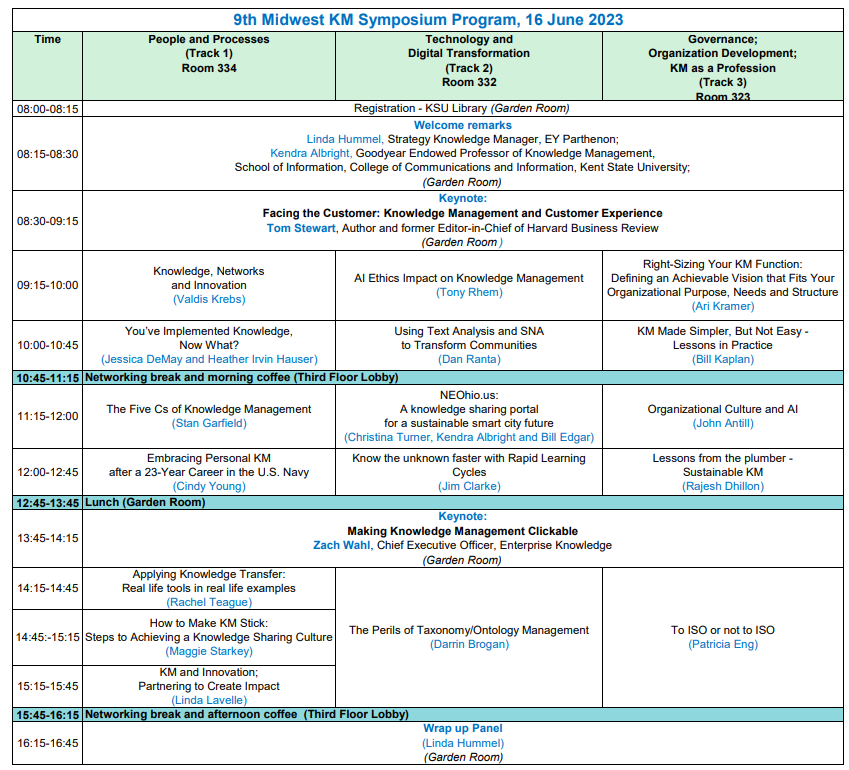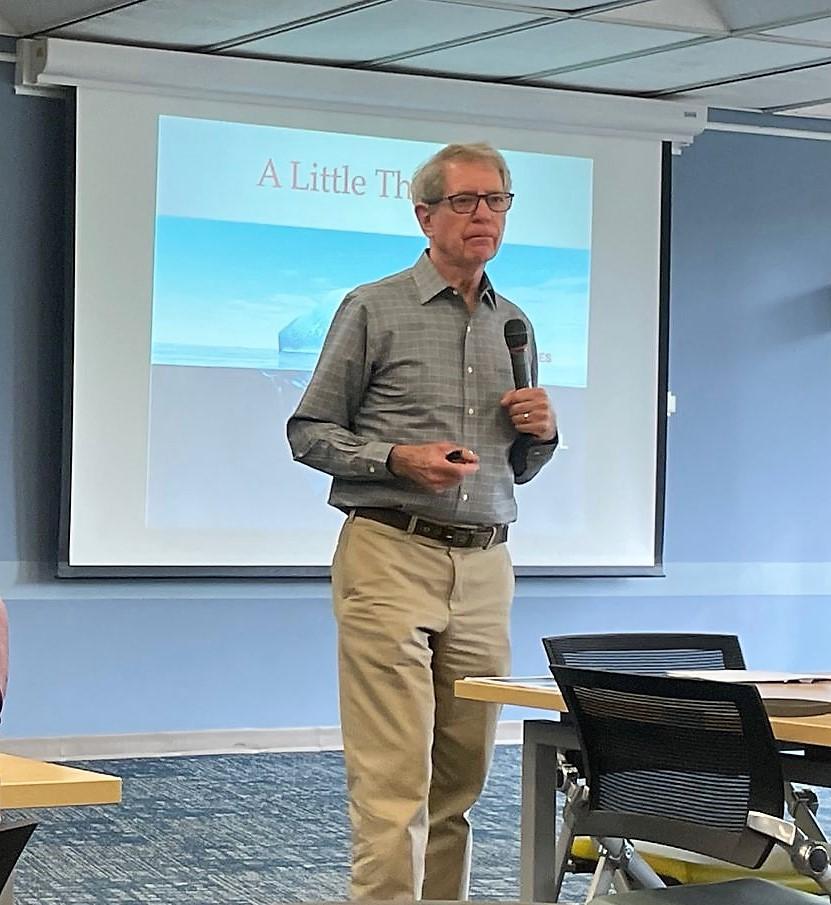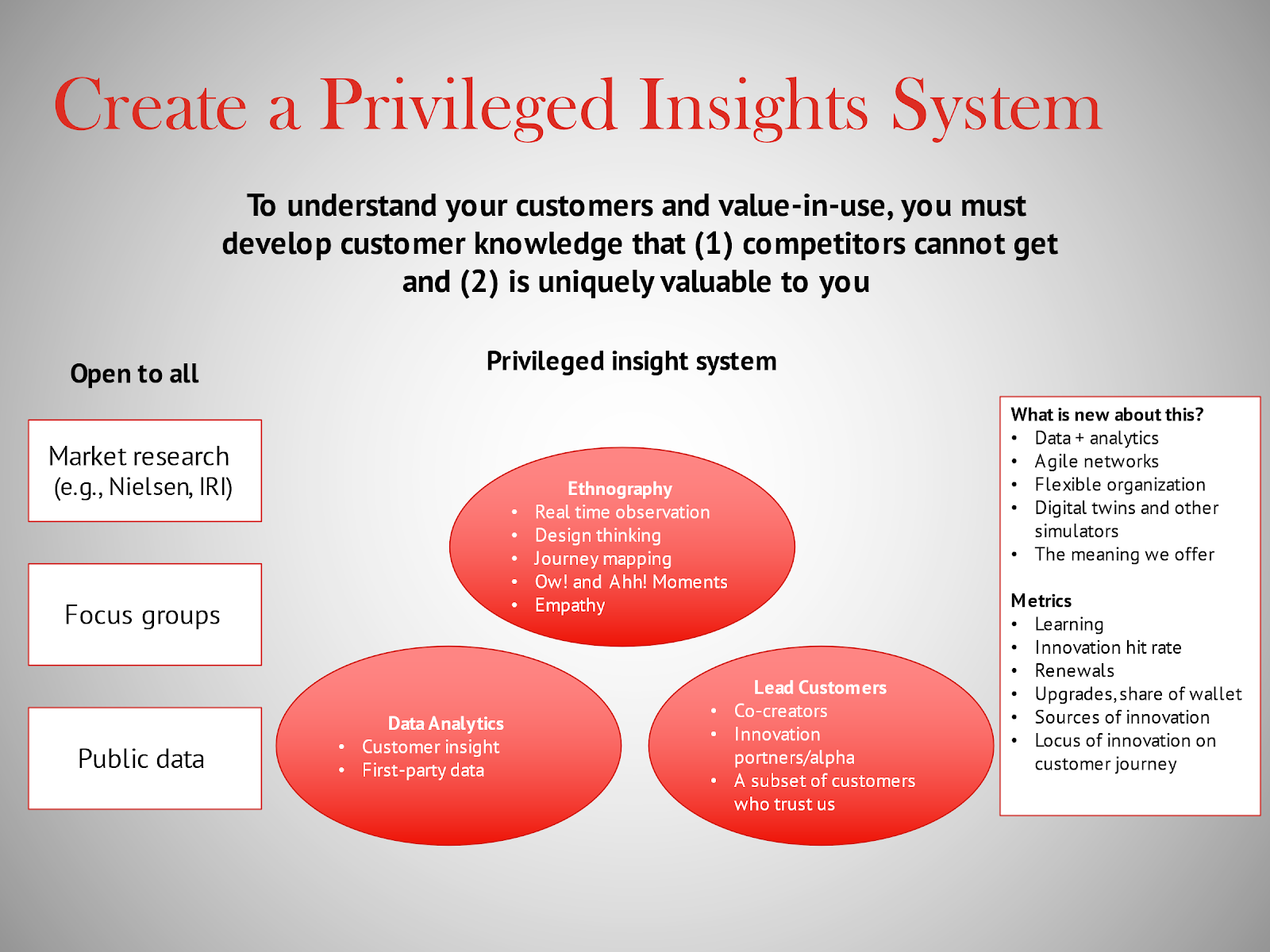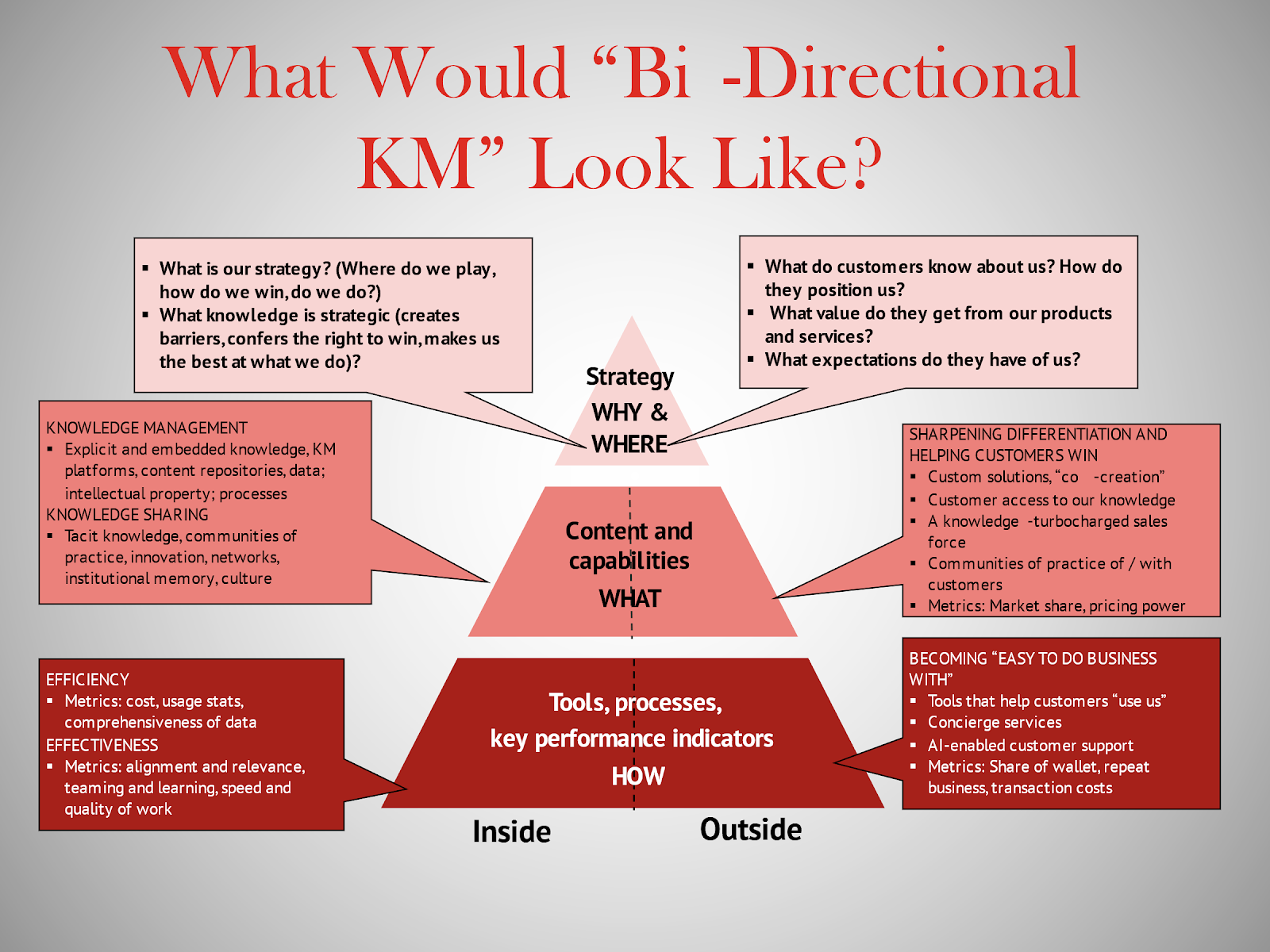9th Annual Midwest KM Symposium: Part 1 – Tom Stewart

Stan Garfield
The Midwest Knowledge Management Symposium was held on June 16, 2023 at Kent State University in Kent, Ohio. It was the first time the event was held since 2020, and the first time it was held in person since 2019.
The goals of the symposium are to provide an opportunity for anyone who wants to speak to do so, to allow those in the midwestern U.S. to attend a significant event within driving distance, and to provide a high-value conference with an affordable registration fee.
This year’s co-chairs were Linda Hummel, Strategy Knowledge Manager, EY Parthenon and Kendra Albright, Goodyear Endowed Professor of Knowledge Management, School of Information, College of Communications and Information, Kent State University. The event sponsors were Lucidea, Enterprise Knowledge, and Bloomfire.
The first Midwest KM Symposium was held in Detroit in 2008. The next two were held in Chicago in 2009 and 2010. Cleveland was the location in 2011, 2017, and 2018. The last in-person event was in Cincinnati in 2019, and there was a virtual symposium in 2020.
2023 Program

I presented “The Five Cs of Knowledge Management” and attended eight other presentations:
- Morning Keynote: “Facing the Customer: The Customer’s Knowledge Journey – Knowledge Management and Customer Experience” by Tom Stewart
- “Knowledge Serendipity: Networks, Conversations, and Interactions” by Valdis Krebs
- “Using Text Analysis and SNA to Transform Communities” by Dan Ranta
- “Lessons from the Plumber: Sustainable KM” by Rajesh Dhillon
- Afternoon Keynote: “Making Knowledge Management Clickable” by Zach Wahl
- “Applying Knowledge Transfer: Real Life tools in Real Life Examples” by Rachel Teague
- “How to Make KM Stick: Steps to Achieving a Knowledge Sharing Culture” by Maggie Starkey
- “KM and Innovation: Partnering to Create Impact” by Linda Lavelle
Starting this week, I will blog about each of these eight sessions. This post is about the morning keynote delivered by Tom Stewart.
Facing the Customer: The Customer’s Knowledge Journey—KM and Customer Experience
- Thomas A. Stewart, author of Intellectual Capital and The Wealth of Knowledge; co-author of Woo, Wow, and Win; and former Editor-in-Chief of Harvard Business Review

Tom started by asking the question, “How does knowledge management relate to customer delight?” He proceeded to answer this question, drawing on his experience in writing about KM and service design.
KM has focused on knowledge that resides in the organization.
- Human capital: Who knows what, what knowledge is needed for a task or role, knowledge sharing, internal communities of practice
- Structural capital: Documentation of processes, analysis and curation of IP, data, and information, best practices, “single version of the truth”
- Customer capital: brand, digital asset management, CRM, “single view of the customer”
Knowledge is a critical part of a customer’s journey.
- What does the customer know or need to know to make a decision?
- What knowledge do we need to serve the customer?
- From whom and where does the customer get knowledge?
- How do we move internal knowledge from one touchpoint to another without reentering data?
Tom discussed six customer experience knowledge problems.
- Knowledge Problem #1: Choice. There are too many choices, so make it easier to choose.
- Knowledge Problem #2: How Do I? Make products and services simpler.
- Knowledge Problem #3: Service. Make it easy to do business with you.
- Knowledge Problem #4: Coherence. Customers should have a single view of the company and its partners, independent of the channel or platform used.
- Knowledge Problem #5: Customer Perceived Value. “People don’t want to buy a quarter-inch drill. They want a quarter-inch hole!”
- Knowledge Problem #6: Customer Success. Help your customers become power users.
He suggested creating a privileged insights system to hold proprietary customer knowledge.

Tom asked what bi-directional KM would look like, and proposed an approach where knowledge flows between the company and its customers in both directions.

Tom then offered eight initiatives to apply KM to strengthen customer experience and create customer capital.
- Identify customers’ knowledge needs at key touchpoints. What must they know to make decisions, get the most value?
- Identify internal knowledge needs at key touchpoints. What must you know to “win” this touchpoint?
- Share knowledge horizontally, vertically, with partner companies, and with customers.
- Integrate KM and CRM: knowledge for customers and knowledge about them.
- Forge continuous learning loops among customers, your front line, and the back office.
- Use KM tools to help customers use your products and services better.
- Develop knowledge-based ways to increase customers’ value to you and yours to them—e.g., co-creation.
- Create knowledge repositories and communities of practice for and with customers.
Tom concluded his talk by providing three sets of three questions that should be asked.
The knowledge strategist’s fundamental questions:
- What knowledge sets us apart from our competitors?
- How should we create, renew, or extend our knowledge?
- What is our knowledge worth?
The knowledge manager’s fundamental questions:
- How can we capture what we learn?
- How can we distribute knowledge to people who need it?
- How can we get more out of the knowledge we have?
The experience designer’s fundamental questions:
- What experience do we want our customer to have?
- What does our customer see at each stage of his or her journey?
- What must happen backstage to make the magic happen every time?
Tom Stewart’s presentation was engaging, humorous, and insightful. Combining knowledge management and customer experience design is an important step for making KM valuable within organizations. For more about Tom Stewart and his writing, see my Profile in Knowledge.

Stan Garfield
Please enjoy Stan’s blog posts offering advice and insights drawn from many years as a KM practitioner. You may also want to download a free copy of his book, Lucidea’s Lens: Special Librarians & Information Specialists; The Five Cs of KM from Lucidea Press, and its precursor, Proven Practices for Implementing a Knowledge Management Program. Learn about Lucidea’s Presto, SydneyEnterprise, and GeniePlus software with unrivaled KM capabilities that enable successful knowledge curation and sharing.
Never miss another post. Subscribe today!
Similar Posts
Lucidea’s Lens: Knowledge Management Thought Leaders Part 79 – David Garvin
KM expert David Garvin was a proponent of organizational learning to counter unpredictability in market forces and technology advances.
Lucidea’s Lens: Knowledge Management Thought Leaders Part 78 – Carl Frappaolo
KM expert Carl Frappaolo was the creator of Delphi’s Knowledge Management Methodology (KM2)
Lucidea’s Lens: Knowledge Management Thought Leaders Part 77 – Leif Edvinsson
Leif Edvinsson, Professor Emeritus at Lund University in Sweden, specializes in Intellectual Capital Management of Enterprises, Cities, and Nations
Lucidea’s Lens: Knowledge Management Thought Leaders Part 76 – Seth Earley
Seth Earley works in cognitive computing, knowledge engineering, data management systems, taxonomy, ontology, and metadata governance strategies.

Leave a Comment
Comments are reviewed and must adhere to our comments policy.
0 Comments